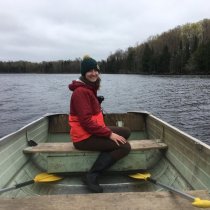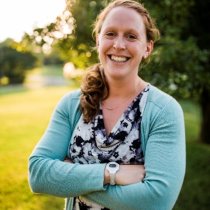Women in Ecology - Ana Bento
October 14, 2020
Ecology comprises a vast array of disciplines, and it is this variety that draws scientists with diverse interests and backgrounds to the field as a whole. We chatted with Dr. Ana Bento, assistant professor in the School of Public Health at Indiana University, about her work in infectious diseases and microparasitic infections, which may seem quite different from botany, zoology, and other related ecological disciplines. But as the COVID-19 pandemic has shown us, diseases and vectors are a constant component of the larger world we inhabit. Understanding them in the broader context of ecology is more important than ever.
As we’ve seen throughout our Women in Ecology series, mentorship and engagement come repeatedly to the forefront as critical ingredients in the effort to diversify students and researchers involved in STEM. Dr. Bento discussed how her current work has taken on new meaning during the pandemic, and also how mentors sparked her interest in her field.
Q: What inspired you to become involved in your current research/field?
My career in infectious diseases happened accidentally, like all cool things do. When I was still working on my Ph.D. I saw a seminar by Jess Metcalf on measles dynamics. I was fascinated by her talk and I fell in love with disease systems.
Q: Please tell us a little about your career path.
I moved to the United Kingdom to get a degree in Biology and a Ph.D. in Ecology and Evolution, both from Imperial College London. I was working on climate effects and plant herbivore interactions of Soay sheep and red deer. I spent half of my time developing mathematical and statistical models and the other half chasing sheep and deer up hills. It was glorious! Upon graduation I went to the Infectious Disease Epidemiology department at Imperial to start a fellowship on bovine tuberculosis and vaccine modeling. In 2015, I decided to try a new adventure and moved to the United States for a fellowship at the University of Georgia with Pejman Rohani. And hence began my love affair with childhood diseases.
Q: Who were your most important influences/mentors in ecological science?
Dr. Mick Crawley, my Ph.D. advisor at Silwood Park Imperial College, hands down. He was a great teacher and great human all around. Also Pejman Rohani, whose love of science and of a good puzzle was so inspiring. We worked together during our time at the University of Georgia, and he kept me going in hard times.
Q: What challenges do you think women may face getting into STEM fields? Have you experienced or overcome any of these?
The dreaded leaky pipeline. To be very honest, I have been fortunate to not have been in (or perhaps at times too naïve to notice) any situation where my being a woman was a hindrance, but the leaky pipeline remains an issue.
Q: How can research and educational institutions inspire more women to study fields in ecology?
The more of us there are in senior positions, the more achievable it will be for young women to believe they can be successful in this field. Creating equitable environments is key as well. While I was in the U.K., I was part of an evaluation team at the Imperial College infectious diseases department. It was called the Athena awards, which aims to create an environment for women to succeed in STEM fields, and now it’s expanded to humanities and more. It awards female students to highlight and promote best practices. I think programs like these are helpful as they evaluate and create a framework for institutions and departments to continuously improve. As a faculty member I am involved with coding clubs to empower girls early to embrace coding and quantitative skills.
Q: What work are you most proud of at this point in your career?
I’m most proud of working on whooping cough to understand how evolution plays a role in the re-emergence of diseases that theoretically are candidates for eradication.
Q: What do you hope to do in your field in the future?
I would like to continue working on understanding why some pathogens emerge in certain populations but not all. Integrating both ecological evolution and epidemiology to holistically tackle these issues, such as vaccine strain selection and immune evasion, is also an important goal of mine.
Q: What is the most satisfying part of being an ecologist? What is the most challenging?
The most satisfying is looking for mechanistic explanations of mysteries. The most challenging is finding the right data to explore hypotheses.
Q: Tell us more about your current work on understanding long-term data on spatio-temporal incidence patterns of microparasitic infections such as pertussis, measles, and bovine tuberculosis. In addition, can you elaborate more about your new projects on COVID-19?
I use mathematical models, computational simulations, and statistical analysis to study the dynamics of infectious diseases at different spatial and temporal scales. What this means is that I take time series of different populations at several scales (e.g. city, state, county) and try to dissect drivers of the underlying processes affecting disease. A lot of the work I do is framed by understanding optimal control strategies, hence vaccination, which is the connection between pertussis, measles, and bovine tuberculosis.
For COVID-19 I have been more fascinated in human behavior and how it affects the risk of disease and transmission. For this I have a few collaborations with economists looking at adaptative behavior and the role of policy on transmission. I am also collaborating with other groups to understand how heterogeneity at the geographical level leads to different genomic signatures in the population, and how this might be useful in situations where testing is below necessary coverage levels.
Q: What is the most alarming discovery you have made? What is the most promising?
The most alarming discovery I’ve made is that sometimes humans think of diseases as a “me” problem and not a community problem, and that can have significant downstream consequences. The most promising discovery is that by understanding pathogen evolution, we can more effectively create adaptative and efficient control strategies.
###



